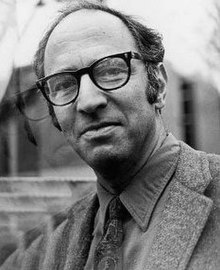Kuhnian
| Thomas Kuhn | |
|---|---|
 |
|
| Born |
Thomas Samuel Kuhn July 18, 1922 Cincinnati, Ohio, U.S. |
| Died | June 17, 1996 (aged 73) Cambridge, Massachusetts, U.S. |
| Alma mater | Harvard University |
| Era | 20th-century philosophy |
| Region | Western philosophy |
| School |
Analytic Historical turn |
|
Main interests
|
Philosophy of science |
|
Notable ideas
|
|
|
Influenced
|
|
Thomas Samuel Kuhn (/kuːn/; July 18, 1922 – June 17, 1996) was an American physicist, historian and philosopher of science whose controversial 1962 book The Structure of Scientific Revolutions was influential in both academic and popular circles, introducing the term paradigm shift, which has since become an English-language idiom.
Kuhn made several notable claims concerning the progress of scientific knowledge: that scientific fields undergo periodic "paradigm shifts" rather than solely progressing in a linear and continuous way, and that these paradigm shifts open up new approaches to understanding what scientists would never have considered valid before; and that the notion of scientific truth, at any given moment, cannot be established solely by objective criteria but is defined by a consensus of a scientific community. Competing paradigms are frequently incommensurable; that is, they are competing and irreconcilable accounts of reality. Thus, our comprehension of science can never rely wholly upon "objectivity" alone. Science must account for subjective perspectives as well, since all objective conclusions are ultimately founded upon the subjective conditioning/worldview of its researchers and participants.
Kuhn was born in Cincinnati, Ohio, to Samuel L. Kuhn, an industrial engineer, and Minette Stroock Kuhn, both Jewish. He graduated from The Taft School in Watertown, CT, in 1940, where he became aware of his serious interest in mathematics and physics. He obtained his BS degree in physics from Harvard University in 1943, where he also obtained MS and PhD degrees in physics in 1946 and 1949, respectively, under the supervision of John Van Vleck. As he states in the first few pages of the preface to the second edition of The Structure of Scientific Revolutions, his three years of total academic freedom as a Harvard Junior Fellow were crucial in allowing him to switch from physics to the history and philosophy of science. He later taught a course in the history of science at Harvard from 1948 until 1956, at the suggestion of university president James Conant. After leaving Harvard, Kuhn taught at the University of California, Berkeley, in both the philosophy department and the history department, being named Professor of the History of science in 1961. Kuhn interviewed and tape recorded Danish physicist Niels Bohr the day before Bohr's death. At Berkeley, he wrote and published (in 1962) his best known and most influential work:The Structure of Scientific Revolutions. In 1964, he joined Princeton University as the M. Taylor Pyne Professor of Philosophy and History of Science. He served as the president of the History of Science Society from 1969–70. In 1979 he joined the Massachusetts Institute of Technology (MIT) as the Laurance S. Rockefeller Professor of Philosophy, remaining there until 1991. In 1994 Kuhn was diagnosed with lung cancer. He died in 1996.
...
Wikipedia
